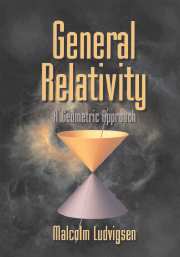Book contents
- Frontmatter
- Contents
- Preface
- PART ONE THE CONCEPT OF SPACETIME
- PART TWO FLAT SPACETIME AND SPECIAL RELATIVITY
- PART THREE CURVED SPACETIME AND GRAVITY
- 9 Curved Spacetime
- 10 Curvature and Gravity
- 11 Null Congruences
- 12 Asymptotic Flatness and Symmetries
- 13 Schwarzschild Geometries and Spacetimes
- 14 Black Holes and Singularities
- PART FOUR COSMOLOGY
- Solutions and Hints to Selected Exercises
- Bibliography
- Index
13 - Schwarzschild Geometries and Spacetimes
Published online by Cambridge University Press: 04 June 2010
- Frontmatter
- Contents
- Preface
- PART ONE THE CONCEPT OF SPACETIME
- PART TWO FLAT SPACETIME AND SPECIAL RELATIVITY
- PART THREE CURVED SPACETIME AND GRAVITY
- 9 Curved Spacetime
- 10 Curvature and Gravity
- 11 Null Congruences
- 12 Asymptotic Flatness and Symmetries
- 13 Schwarzschild Geometries and Spacetimes
- 14 Black Holes and Singularities
- PART FOUR COSMOLOGY
- Solutions and Hints to Selected Exercises
- Bibliography
- Index
Summary
An isolated physical body such as a star may be described in terms of a spacetime picture by an asymptotically flat spacetime, (M, g), containing a world tube representing the region of M occupied by the body. Inside the world tube, the energy–momentum tensor, Tab, will be nonzero and should describe some physically reasonable matter distribution. Outside, in the vacuum, matter-free region, Tab=0, and hence, by Einstein's equation, Rab = 0. The curvature, and hence the gravitational field, in the vacuum region is thus completely given by the Weyl tensor, that is, Rabcd = Cabcd.
While the situation described above serves as a framework for the discussion of isolated bodies in general relativity, it is too general to provide much real information; what we need is some simplification to make it more tractable to calculation. Fortunately, most stars are more or less spherically symmetric and stationary. We can thus obtain a useful, but considerably simpler, model by imposing spherical symmetry and stationarity. The problem of finding the most general spacetime satisfying these conditions was, in fact, essentially solved by Schwarzschild in 1916, not long after Einstein first proposed his general theory of relativity. In particular, he showed that the vacuum region outside a spherically symmetric and stationary body has a simple geometric structure, which we shall refer to as a Schwarzschild geometry, that depends on only one number, m, which may be identified with the total mass of the body. This result is similar to the Newtonian case, where the external gravitational field of any symmetric body is given simply by the inverse square law.
- Type
- Chapter
- Information
- General RelativityA Geometric Approach, pp. 134 - 151Publisher: Cambridge University PressPrint publication year: 1999

